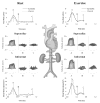Hemodynamic influences on abdominal aortic aneurysm disease: Application of biomechanics to aneurysm pathophysiology
- PMID: 20347049
- PMCID: PMC2880166
- DOI: 10.1016/j.vph.2010.03.004
Hemodynamic influences on abdominal aortic aneurysm disease: Application of biomechanics to aneurysm pathophysiology
Abstract
"Atherosclerotic" abdominal aortic aneurysms (AAAs) occur with the greatest frequency in the distal aorta. The unique hemodynamic environment of this area predisposes it to site-specific degenerative changes. In this review, we summarize the differential hemodynamic influences present along the length of the abdominal aorta, and demonstrate how alterations in aortic flow and wall shear stress modify AAA progression in experimental models. Improved understanding of aortic hemodynamic risk profiles provides an opportunity to modify patient activity patterns to minimize the risk of aneurysmal degeneration.
Copyright 2010 Elsevier Inc. All rights reserved.
Figures








Similar articles
-
A Comprehensive Review on Computational Analysis, Research Advances, and Major Findings on Abdominal Aortic Aneurysms for the Years 2021 to 2023.Ann Vasc Surg. 2025 Jan;110(Pt A):63-81. doi: 10.1016/j.avsg.2024.07.111. Epub 2024 Sep 28. Ann Vasc Surg. 2025. PMID: 39343357 Review.
-
High-frequency murine ultrasound provides enhanced metrics of BAPN-induced AAA growth.Am J Physiol Heart Circ Physiol. 2019 Nov 1;317(5):H981-H990. doi: 10.1152/ajpheart.00300.2019. Epub 2019 Sep 27. Am J Physiol Heart Circ Physiol. 2019. PMID: 31559828 Free PMC article.
-
Low wall shear stress predominates at sites of abdominal aortic aneurysm rupture.J Vasc Surg. 2016 Jun;63(6):1613-9. doi: 10.1016/j.jvs.2015.01.040. Epub 2015 Mar 7. J Vasc Surg. 2016. PMID: 25752691
-
Biomechanical Indices for Rupture Risk Estimation in Abdominal Aortic Aneurysms.J Endovasc Ther. 2017 Apr;24(2):254-261. doi: 10.1177/1526602816680088. Epub 2016 Nov 21. J Endovasc Ther. 2017. PMID: 27872318 Review.
-
Flow-induced wall shear stress in abdominal aortic aneurysms: Part I--steady flow hemodynamics.Comput Methods Biomech Biomed Engin. 2002 Aug;5(4):309-18. doi: 10.1080/1025584021000009742. Comput Methods Biomech Biomed Engin. 2002. PMID: 12186710
Cited by
-
A preclinical ultrasound method for the assessment of vascular disease progression in murine models.Ultrasound. 2019 May;27(2):85-93. doi: 10.1177/1742271X18793919. Epub 2018 Aug 7. Ultrasound. 2019. PMID: 31037092 Free PMC article.
-
Hemoglobin homeostasis in abdominal aortic aneurysm: diagnostic and prognostic potential of hemoglobin/heme and scavenger molecules.BMC Cardiovasc Disord. 2024 Aug 27;24(1):452. doi: 10.1186/s12872-024-04131-3. BMC Cardiovasc Disord. 2024. PMID: 39192217 Free PMC article.
-
[Animal experimental study on the effects of different levels of amputation on cardiovascular system].Sheng Wu Yi Xue Gong Cheng Xue Za Zhi. 2023 Jun 25;40(3):515-521. doi: 10.7507/1001-5515.202211004. Sheng Wu Yi Xue Gong Cheng Xue Za Zhi. 2023. PMID: 37380391 Free PMC article. Chinese.
-
A computational simulation of the effect of hybrid treatment for thoracoabdominal aortic aneurysm on the hemodynamics of abdominal aorta.Sci Rep. 2016 Mar 31;6:23801. doi: 10.1038/srep23801. Sci Rep. 2016. PMID: 27029949 Free PMC article.
-
Investigating heartbeat-related in-plane motion and stress levels induced at the aortic root.Biomed Eng Online. 2019 Feb 26;18(1):19. doi: 10.1186/s12938-019-0632-7. Biomed Eng Online. 2019. PMID: 30808342 Free PMC article.
References
-
- Abbruzzese TA, Guzman RJ, Martin RL, Yee C, Zarins CK, Dalman RL. Matrix metalloproteinase inhibition limits arterial enlargements in a rodent arteriovenous fistula model. Surgery. 1998;124:328–334. - PubMed
-
- Ailawadi G, Eliason J, Upchurch G., Jr Current concepts in the pathogenesis of abdominal aortic aneurysm. J Vasc Surg. 2003a;38:584–588. - PubMed
-
- Ailawadi G, Knipp BS, Lu G, Roelofs KJ, Ford JW, Hannawa KK, Bishop K, Thanaporn P, Henke PK, Stanley JC, Upchurch GR., Jr A nonintrinsic regional basis for increased infrarenal aortic MMP-9 expression and activity. J Vasc Surg. 2003b;37:1059–1066. - PubMed
-
- Anidjar S, Salzmann JL, Gentric D, Lagneau P, Camilleri JP, Michel JB. Elastase-induced experimental aneurysms in rats. Circulation. 1990;82:973–981. - PubMed
-
- Ashton HA, Buxton MJ, Day NE, Kim LG, Marteau TM, Scott RAP, Thompson SG, Walker NM. The Multicentre Aneurysm Screening Study (MASS) into the effect of abdominal aortic aneurysm screening on mortality in men: a randomised controlled trial. Lancet. 2002;360:1531–1539. - PubMed
Publication types
MeSH terms
Grants and funding
LinkOut - more resources
Full Text Sources
Medical

